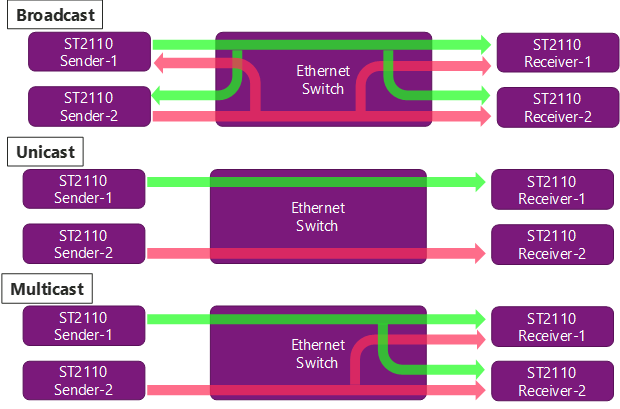1.First of all
SMPTE ST 2110 Professional Media Over Managed IP Networks (hereinafter referred to as SMPTE 2110 or ST2110) is an SMPTE standard that is an evolving set of standards for communicating professional video such as broadcasting over IP networks. With the standardization of this standard, the industry is transitioning from SDI-based to IP-based transmission. Macnica develops and provides FPGA / Software solutions such as the "SMPTE ST2110 FPGA IP Core" that allow customers to easily implement this standard.
Last time, we introduced the configuration of SMPTE 2110 Suite. This time, we will explain about IP transmission using SDI to IP Gateway.
2. SDI to IP Gateway
As I wrote in my last column, the current broadcast industry is in the process of making the switch from SDI-based to IP-based transport. Until now, broadcasting systems have been built on an SDI basis, and SDI equipment is still in use. An SDI to IP Gateway is required during the transition period to switch to IP base while utilizing these assets.

One of the major features of SMPTE 2110 is "transmitting each essence of Media Data (Video, Audio, and Metadata) as separate synchronized streams". SDI to ST2110 IP Gateway separates SDI essence into Video, Audio and Metadata essences and converts them to IP.
For SDI to IP conversion, each essence is encapsulated in RTP format and then encapsulated in UDP/IP format (Encap). After that, it is Ethernet packetized (framing) and sent to the IP network. In the case of IP to SDI conversion, the reverse procedure (Deframing ⇒ Decap) becomes SDI essence and SDI output.
In order to synchronize each essence stream, the RTP timestamp is stored in the RTP packet header during encapsulation, and the RTP timestamp is referenced during decapsulation. I will explain stream synchronization in another column.
3. From SDI transmission to IP transmission
However, it is not the case that IP transmission can be started immediately by connecting a device such as an SDI to IP Gateway. IP transmission is not completed just by arranging the equipment. IP transmission is very different from SDI transmission.
The obvious change from SDI transmission to IP transmission is the procedure up to the start of “video data transfer”. SDI transmission is based on point-to-point connections, so video data was communicated by connecting the output of the Sender to the input of the Receiver. With IP transmission, plug and play like SDI transmission is no longer possible. IP Address and MAC Address settings are required because it is IP-enabled. Furthermore, when transmitting with Multicast, settings such as IGMP are also required.

Even in the “Simple ST2110 connection example” above, the following steps must be taken to communicate video data.
(1) Ethernet L2 Switch settings (Multicast, Port attributes, etc.)
② Time synchronization between PTP Master and ST2110 Sender/Receiver
(3) Set IP Address information etc. on the Receiver side to ST2110 Sender
④For Multicast, make ST2110 Receiver join IGMP

The keyword Multicast mentioned above is one of the data transmission methods on the IP network.
◎Broadcast
◆Distribute data to all connected ports
◎Unicas t
◆ Distribute data to a specific port
◎Multicast
◆ Data is sent to a specific port, but multiple data is delivered at the same time

Multicast, which allows one-to-N connections, is often used for IP transmission of business video. This is because the 1: N connection allows the Ethernet Switch to also function as an SDI Router. (This is a big advantage of IP transmission!)Broadcast also looks like a one-to-N connection at first glance, but Broadcast is a method of distributing data to all ports connected to the Switch. Therefore, it is rarely used for Media transmission because it can cause bandwidth overruns.
Ethernet Switch settings are also important. Flooding may occur due to insufficient Switch settings, and even if it appears to be operating normally at first glance, it is actually possible that the bandwidth is exceeded and Packet Loss etc. occurs frequently.
Furthermore, with Ethernet, packet drop, reordering, and duplication may occur along the route. (This point can be recovered to some extent if the device conforms to the ST2022-7 standard. In general, the ST2110 system also introduces and complies with this ST2022-7 standard.)
4. Advantages of IP Transmission
As you can see, IP transmission requires more work and considerations than SDI transmission, which tends to be a disadvantage. However, IP transmission has great advantages in terms of flexibility and scalability.
◎Taking 10G Ethernet as an example, 6 channels of HD content can be bi-directionally transmitted with a single cable.
◎Even if the data rate required for media transmission increases, it can be handled simply by changing the Ethernet Switch, etc.
◎ Route switching and distribution can also be performed with Ethernet Switch
◎ COTS products can also be used
◎ Media transmission and control can be performed on the same route
If you focus on "what can be done because of IP transmission", you can see the merits of IP transmission. As mentioned earlier, the current broadcast industry has already begun to switch from SDI-based to IP-based transmission. In addition, as the performance of network equipment and network technology continue to improve, it is believed that the trend toward IP transmission of business-related video will continue to accelerate in the future.
From the next time, we plan to talk about each standard of the ST2110 Suite.
To the product [Media Over IP Package] page
Media Over IP Package is a packaged product of ST2110 hardware IP / software development kit / reference design.
Related information links
Please also refer to the technical information page regarding IPMX.
